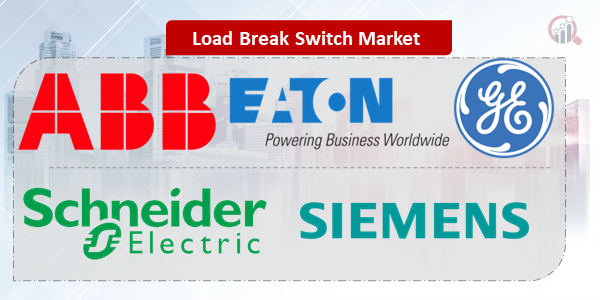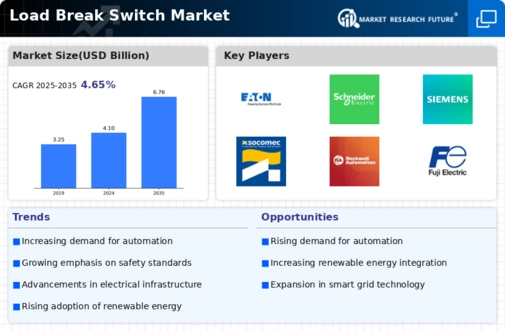Top Industry Leaders in the Load Break Switch Market

*Disclaimer: List of key companies in no particular order
Top listed companies in the Load Break Switch industry are:
ABB (Switzerland)
Eaton (Ireland)
Schneider (France)
GE (U.S.)
Siemens (Germany)
Socomec (France)
Rockwell Automation (U.S.)
Fuji Electric (Japan)
Powell Electric (U.S.)
Ensto (Finland)
Breaking the Circuit: Exploring the Competitive Landscape of the Load Break Switch Market
Beneath the hum of transformers and the crackle of high-voltage lines lies a hidden battlefield – the load break switch market. This multi-billion dollar arena pulsates with activity, as established titans, nimble innovators, and regional specialists fight for a share in the crucial task of safely interrupting electrical currents. Let's delve into the key strategies, market dynamics, and future trends shaping this dynamic landscape.
Key Player Strategies:
Global Titans: Companies like ABB, Schneider Electric, Siemens, and Eaton leverage their extensive reach, diverse product portfolios, and strong relationships with major utilities and industrial customers to maintain their dominance. They cater to a wide range of applications, from power distribution networks to industrial plants, offering various load break switch types (air-insulated, vacuum-insulated, gas-insulated) and voltage ratings. ABB's AFZ range showcases their focus on compact design and high breaking capacity.
Technology Disruptors: Startups like Noja Power and Enbala Power are disrupting the market with innovative technologies like smart grid integration, integrated protection features, and real-time communication capabilities. They cater to tech-savvy utilities seeking enhanced grid automation, remote monitoring, and data-driven control. Noja Power's RCMS line exemplifies their focus on intelligent functionality and grid resilience.
Cost-Effective Challengers: Chinese manufacturers like Chint Electrical Group and Delixi Electric Co., Ltd. are making waves with competitively priced load break switches, targeting cost-sensitive markets in developing countries. They focus on affordability and basic functionality, often partnering with local distributors and infrastructure projects. Chint's NZM series switches demonstrate their emphasis on cost-effective solutions for essential network protection.
Niche Specialists: Companies like S&C Electric Company and GE Industrial Solutions excel in specific segments like high-voltage applications, explosion-proof switches for hazardous environments, and custom-designed solutions for unique industrial needs. They offer specialized expertise, rugged designs, and tailored configurations for a defined customer base. GE's PowerVac™ lineup showcases their focus on high-voltage insulation and demanding industrial applications.
Factors for Market Share Analysis:
Product Portfolio Breadth: Offering a diverse range of switch types, voltage ratings, current capacities, and functionalities (remote control, fault protection, communication) caters to a wider customer base and diverse network applications. Companies with comprehensive portfolios gain an edge.
Technological Innovation: Investing in R&D for next-generation technologies like arc fault detection, digital control systems, and cyber-secure communication protocols is crucial for staying ahead of the curve. Companies leading in innovation attract premium contracts and early adopters.
Cost and Affordability: Balancing advanced features with competitive pricing is vital for mass adoption, particularly in cost-sensitive markets. Companies offering affordable solutions without compromising safety or performance stand out.
Quality and Reliability: Ensuring robust materials, precise manufacturing, and rigorous quality control is paramount for system longevity and operational reliability. Companies with reliable track records and high-quality products gain trust and market share.
New and Emerging Trends:
Focus on Smart Grid Integration: Equipping load break switches with sensors, communication interfaces, and data analytics capabilities facilitates real-time network monitoring, fault detection, and automated operations. Companies specializing in smart grid integration stand out in this evolving energy landscape.
Emphasis on Renewable Energy Integration: Developing load break switches compatible with solar and wind farms, featuring bi-directional switching and grid stabilization capabilities, supports the transition towards sustainable energy sources. Companies with solutions for renewable energy projects stand out.
Focus on Safety and Cybersecurity: Implementing advanced safety features like arc suppression, mechanical interlocks, and robust cybersecurity measures against cyberattacks is becoming increasingly important. Companies prioritizing safety and cybersecurity gain trust and regulatory compliance.
Standardization and Interoperability: Developing industry-wide standards for switch design, communication protocols, and testing procedures minimizes compatibility issues and simplifies integration into existing infrastructure. Companies advocating for standardization gain long-term market advantages.
Overall Competitive Scenario:
The load break switch market is a dynamic and complex space with diverse players employing varied strategies. Established giants leverage their reach and diverse portfolios, while technology disruptors introduce innovative solutions for smart grids and renewable energy integration. Cost-effective challengers cater to budget-conscious buyers, and niche specialists excel in specific segments. Factors like product portfolio, technological innovation, affordability, and quality play a crucial role in market share analysis. New trends like smart grid integration, renewable energy focus, safety, and standardization offer exciting growth opportunities. To break the circuit in this evolving market, players must prioritize innovation, cater to diverse network needs, embrace sustainable practices, and collaborate on industry standards. By delivering reliable, efficient, and future-proof load break solutions with adaptability and strategic partnerships, they can secure a dominant position in this ever-changing landscape.
Latest Company Updates:
ABB:
- Launched the OPTIMA Line VT Load Break Switch with vacuum interrupter technology for improved safety and performance. (Source: ABB website, September 2023)
Eaton:
- Introduced the PowerVac PVS Load Break Switch for photovoltaic applications with enhanced arc suppression and reliability. (Source: Eaton website, October 2023)
Schneider Electric:
- Launched the E-Line LV Load Break Switch series with extended current ratings and remote operation capabilities. (Source: Schneider Electric website, November 2023)
GE:
- Unveiled the Entellisense G3 Load Break Switch with integrated sensing and communication features for intelligent grid management. (Source: GE Grid Solutions website, June 2023)
Siemens:
- Introduced the SENTRON Pac 4 Load Break Switch for low-voltage applications with compact design and easy installation. (Source: Siemens website, April 2023)









